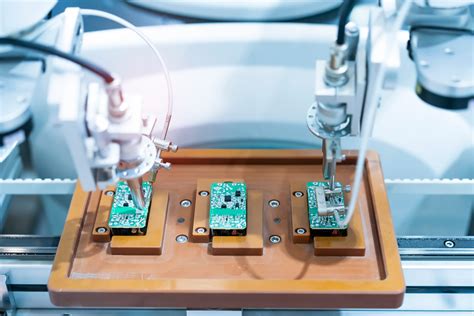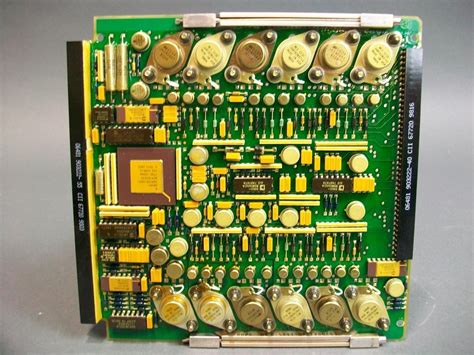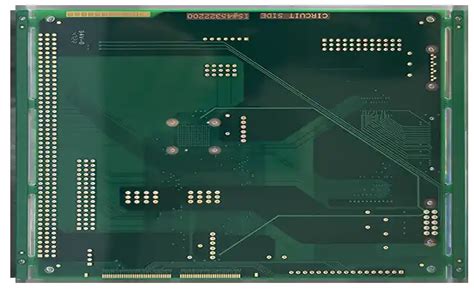Revolutionizing Electronics: The Future of Automated PCB Manufacturing
Key Takeaways
The shift towards automated PCB manufacturing represents a significant transformation within the electronics sector. This evolution has been significantly fueled by the increasing demand for speed and efficiency in production processes, alongside the simultaneous desire for high-quality pcba products. The integration of cutting-edge technologies is not just improving productivity; it is redefining the entire landscape of pcb assembly. For instance, advanced robotics are now capable of executing precise and intricate tasks that were previously reliant on human labor. This transition not only enhances the accuracy of each assembly but also significantly reduces the likelihood of errors, thus ensuring that the final products meet stringent quality standards. Moreover, with the infusion of artificial intelligence into these automated systems, manufacturers can harness data-driven insights to optimize processes and implement proactive quality control measures. As a result, businesses are witnessing marked improvements in overall efficiency and cost-effectiveness, creating a more competitive edge in a rapidly evolving market. The future points towards increasingly sophisticated pcba solutions that will support the development of intelligent devices, ultimately leading to widespread implications for global electronics and consumer technology landscapes.
The Evolution of PCB Manufacturing: From Manual to Automated Processes
The transformation of PCB manufacturing has been nothing short of revolutionary. In earlier stages, pcb assembly processes were predominantly manual, requiring skilled labor for every task, from component placement to soldering. This approach was not only time-consuming but also prone to human error, which could compromise the integrity of the electronic products. However, as the demand for smaller and more complex devices surged, manufacturers began to recognize the need for precision and efficiency.
The advent of automation has introduced a myriad of technologies that have redefined how pcba is conducted. The replacement or augmentation of manual labor with advanced machinery has led to significant improvements in both speed and accuracy. Automated pcb assembly lines utilize sophisticated machinery that can place components with unmatched precision, reducing defects and waste. Moreover, automation facilitates a more streamlined workflow that can adapt rapidly to different production volumes and product types.
To further illustrate the contrast between manual and automated processes, consider the following table:
| Aspect | Manual PCB Assembly | Automated PCB Assembly |
|---|---|---|
| Speed | Slower due to reliance on manual labor | Fast with high-speed machines |
| Precision | Subject to human error | Consistent accuracy with minimal errors |
| Scalability | Limited by workforce size | Easily scalable with machine adjustments |
| Cost Efficiency | Higher costs due to labor expenses | Reduced costs through fewer defects |
| Production Flexibility | Challenging to switch between products | Rapid switching capabilities |
As we map this evolution from manual methods to automated systems, it becomes evident that the incorporation of technology in pcb assembly is not just a trend but a necessity for staying competitive in a fast-paced electronics market. This shift not only enhances productivity but also sets a foundation for future advancements in electronics manufacturing, making way for smarter devices built on highly efficient automated processes.
Key Technologies Driving Automation in PCB Production
The integration of advanced technologies is fundamentally transforming PCB assembly processes, making them more efficient and precise. One key driver of this transformation is the use of robotics. Robots are increasingly employed for tasks such as component placement and soldering, which require a high degree of accuracy. This not only speeds up production but also minimizes human error—a crucial factor in the complex world of printed circuit board assemblies (PCBA). Additionally, the advent of smart manufacturing systems, which leverage Internet of Things (IoT) technology, allows for real-time monitoring and adjustments during production. This ensures that any potential issues can be addressed immediately, enhancing overall quality control.
Another significant aspect is the implementation of artificial intelligence within the manufacturing workflow. AI algorithms can analyze vast datasets to predict failures before they occur and optimize processes dynamically based on ongoing performance metrics. This capability leads to more reliable products while also streamlining operations by reducing waste and downtime—factors that are critical in today’s competitive market.
Moreover, technologies like machine vision systems enable enhanced inspection capabilities to validate every aspect of PCBA, ensuring components are placed correctly and that solder joints meet stringent quality standards. The combination of these cutting-edge technologies not only elevates the manufacturing process but also aligns with industry trends toward smart electronics, proving essential for delivering next-generation devices that meet consumer demands for functionality and reliability. In this rapidly evolving landscape, staying at the forefront of technology adoption will be crucial for manufacturers aiming to thrive in a connected world.
The Role of Robotics in Enhancing PCB Assembly Lines
The integration of robotics into pcb assembly processes is a significant advancement in the realm of automated manufacturing. These machines are not only transforming the efficiency of printed circuit board assembly (PCBA) but are also elevating the overall quality and consistency of the products produced. By automating repetitive tasks, robotics reduce human error and enable high-speed operations that were previously unattainable. As a result, manufacturers can achieve tighter tolerances and superior precision, which are indispensable for modern electronic devices.
Robotic systems can meticulously handle components, placing them with exacting accuracy, which is pivotal in the crowded spaces typical of pcba products. This level of precision is increasingly crucial as components shrink while functionality increases. Moreover, robotics can work tirelessly without breaks, thus significantly enhancing production output and meeting global demand for electronics.
“Maintaining high standards in PCB assembly is no longer just about human skill; it’s about leveraging technology to push boundaries.”
Furthermore, the implementation of collaborative robots—often referred to as cobots—is revolutionizing how humans interact with machines on the assembly line. These cobots are designed to work alongside human operators safely and efficiently, enhancing productivity while lowering injury risks associated with repetitive tasks. As robotics evolve, they will become more versatile and capable of undertaking increasingly complex assembly functions in PCB manufacturing.
Overall, as robotics continue to streamline and enhance pcb assembly, they promise exciting opportunities for innovation in electronic device production. These advancements not only drive efficiency but also pave the way for creating smarter products that cater to ever-evolving consumer needs.
Artificial Intelligence: Revolutionizing Quality Control in PCB Manufacturing
The integration of Artificial Intelligence (AI) into the realm of PCB manufacturing is fundamentally transforming the landscape of quality control, elevating standards and minimizing errors. In the traditional manufacturing environment, human oversight was imperative for ensuring that each PCB assembly or PCBA met rigorous quality benchmarks. However, with the advent of AI technologies, companies can now leverage advanced algorithms and machine learning techniques to monitor production processes in real-time. This shift not only enhances accuracy but also dramatically reduces cycle times.
AI systems can analyze vast amounts of data collected during production, identifying patterns and anomalies that may go unnoticed by human operators. By deploying intelligent cameras and sensors along the assembly line, these systems assess each stage of the PCBA process, ensuring that components are correctly placed and soldered with precision. Moreover, predictive analytics can foresee potential failures before they occur, allowing manufacturers to implement corrective actions proactively rather than reactively.
In addition to boosting quality assurance, AI aids in optimizing workflow efficiency by aggregating data on production performance. This leads to informed decision-making that drives continuous improvements in both PCB assembly speed and overall product quality. While integrating AI into manufacturing processes presents its own set of challenges, such as requiring skilled personnel to interpret data insights effectively, the benefits in terms of enhanced reliability and customer satisfaction are substantial. Thus, as we advance further into an era defined by automated systems and data-driven insights, AI stands at the forefront as a catalyst for revolutionizing quality control within the PCB manufacturing industry.
Cost Reduction and Efficiency Gains through Automation
The integration of automation in the manufacturing process of printed circuit boards (PCBs) is fundamentally transforming the landscape of electronics production. One of the most significant advantages is the remarkable cost reduction that arises from streamlined pcb assembly processes. By deploying advanced technologies such as robotics and automated machinery, manufacturers can minimize labor costs and significantly reduce production time. These efficiency gains not only lead to lower overall expenditure but also enable companies to respond more swiftly to market demands, ultimately enhancing their competitive edge.
Furthermore, automated pcb assembly allows for higher precision in production, resulting in less waste and fewer errors. This reduction in defects translates to lower costs associated with rework or product recalls. Additionally, the use of artificial intelligence in quality control systems facilitates rapid adjustments on-the-fly during manufacturing, ensuring optimal performance and consistency in all produced units—elements that are vital for any business aiming for excellence.
As industries continue to adopt automated solutions, the benefits extend beyond immediate financial returns. Companies experience a shift toward sustainable practices through reduced energy consumption and less material waste. Therefore, as automation becomes more pervasive in PCBA operations, not only do we witness significant cost reductions and efficiency gains but we also pave the way for a greener future in electronics manufacturing.
Overcoming Challenges in Transitioning to Automated Manufacturing
Transitioning from traditional methods to automated PCB manufacturing presents several challenges that organizations must address to fully realize the benefits of the latest technologies. One significant hurdle is the initial investment required for advanced machinery and technology. Robotics and state-of-the-art equipment for PCB assembly can be costly, and securing the necessary funding can deter companies from making the leap toward automation. Additionally, there is often resistance to change within established workforces, where employees may feel unsure about their roles in an increasingly automated environment. Training and reskilling workers become crucial to ensure they are equipped with the knowledge and skills required to work alongside machines effectively. Furthermore, maintaining quality during the transition phase is vital, as any discrepancies during automated processes can lead to defects in the PCBA, affecting overall product reliability. This is where implementing effective quality control systems comes into play; leveraging artificial intelligence can significantly enhance these controls, ensuring that automated lines uphold high standards of output. Ultimately, by proactively addressing these challenges with a clear strategy for training, investment, and quality assurance, companies can smoothly shift into a more efficient manufacturing landscape that benefits both their operations and their customers.
Case Studies: Success Stories of Automated PCB Manufacturing
The shift towards automated PCB manufacturing has yielded remarkable success stories across various sectors, showcasing the advantages of pcb assembly innovations. One notable example is a leading electronics company that adopted automation to streamline its production line. By integrating advanced robotics into their pcba processes, they achieved a 30% increase in throughput while maintaining strict quality standards. This transition not only reduced labor costs but also minimized human error, which is often a critical factor in the manufacturing of intricate circuit boards.
Another compelling case involves a startup specializing in wearable technology that combined automation with intelligent design. Their smart factory utilized AI-powered quality control systems, ensuring that every board met rigorous testing criteria before delivery. This automated approach led to a significant reduction in defects and increased customer satisfaction. Furthermore, the ability to swiftly adjust production schedules in response to changing market demands has proven invaluable in this fast-paced industry. Such examples illustrate how companies are not only enhancing operational efficiencies through automated methods but are also setting benchmarks for quality and innovation within the realm of pcb assembly.
Conclusion
The landscape of pcb assembly is undergoing remarkable transformation as automation takes the forefront of pcb manufacturing. With the increasing demand for compact, high-performance electronic devices, the shift towards automation in pcba processes is not just beneficial but essential. Automated systems enhance operational efficiency by significantly reducing production times while minimizing human error. The use of advanced technologies, such as robotics, allows for precise handling and placement of components on printed circuit boards that traditional methods may struggle to achieve consistently. Furthermore, incorporating artificial intelligence in quality control ensures that each unit produced adheres to strict standards, thereby improving overall product reliability. As these innovations continue to evolve, they are poised to redefine standards in the industry and meet the ever-growing expectations of consumers for smarter and more reliable electronic products. In essence, the future of automated PCB manufacturing not only illustrates a greener approach but also sets a path for creating more intelligent devices that can seamlessly integrate into our daily lives.
FAQs
The field of automated PCB manufacturing has led to a myriad of questions as stakeholders seek to understand its implications. One common inquiry is about the differences between PCB assembly and traditional manual approaches. Unlike manual PCBA processes, which can be labor-intensive and prone to human error, automated methods leverage advanced technologies to enhance precision and efficiency. Another frequent question involves the types of key technologies currently influencing automation. Innovations in robotics and artificial intelligence are at the forefront, enabling more precise assembly lines that maintain stringent quality standards. Many also wonder about the impact of these advancements on cost; indeed, automation significantly reduces labor costs and improves output consistency, ultimately leading to substantial savings in production budgets. Furthermore, as industries embrace smart electronics, the question arises concerning the scalability of these automated processes for varied production runs. With flexibility being a critical factor, modern pcb assembly lines can be adjusted with ease, allowing for rapid adaptation to changing market demands. Lastly, individuals often ask how to overcome the hurdles associated with transitioning from traditional methods to automated systems; comprehensive training and phased implementation strategies have proven effective in facilitating this change seamlessly. By addressing these queries, we can foster a better understanding of how automated PCB manufacturing is reshaping the electronics landscape.







